| |
|
|
|
|
||
|
||||||||||||||||||||
|
|

ApproachT his facet of the Ars Electronica Futurelab’s work
focuses on conception, planning and execution of dramaturgical and design
approaches to mediating the public’s encounter with content or to supporting
mediation processes through the use of media art. The designs of corresponding
scenarios are derived from the content supplied by the commissioning client
and the resulting demands that the content places on the mediation process.
The design is then implemented in the form of interactive exhibition and
experience situations at the interface of physical and virtual realms. This
implies a particular conception of space: in the atelier-lab’s interaction
concepts, space - whether an exhibition or an event space or a hybrid of the
two - is a component of the scenography - as an interface, as a transporter of
information, as an intelligent ambience. Ultimately, the interfaces between
human beings and content and between human beings and spaces as transporters
of content are created and implemented in response to the technical, aesthetic
and conceptual challenges that arise thereby.ExperienceExhibitions and Interactive InstallationsT he atelier-lab’s approaches to the design of
exhibitions and interactive installations describe prototypes from the
fields of hands-on experiences, interactive storytelling and collaborative
environments. Their aim is to make possible an intuitive approach to content
via the indirect path of personal and/or shared experience. The many different
forms of media technology employed to achieve this are used as “tools” in
order “to tell stories better” (Bruno Giussani). The characteristics of the
scenography and the interaction design that bring about optimal design and
mediation processes are determined by intuitive parameters and metaphors
meant to encourage orientation, exploration and a process of exchange between
content and those partaking of it.T he atelier-lab’s expertise in this field is the
result of many years of experience producing interactive installations for
the Ars Electronica Center, the Museum of the Future. “Gulliver’s World“,
one of the facility’s longest running and most multifaceted installations,
is based on a non-linear mediation concept. On the basis of intuitive interfaces,
it enables visitors of all age groups to create their own narratives set at
the nexus of material and virtual worlds. The job of mediation entails enabling
the origination of computer games and getting across digital media content
via learning-by-doing on the part of users assuming the roles of prop master,
stage set designer and director. Gulliver’s World has been enhanced by the
addition of the “City Puzzle“
application that turns it into an urban planning simulator, and, since its
initial installation, has been repeatedly adapted to serve as an interactive
presentation platform for product launch events involving a wide variety
of client-supplied content.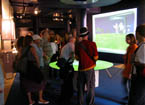
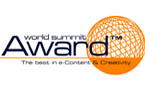
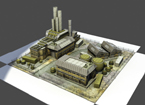 F or the redesign of the “Technology and the Future
of Work” exhibit at the “Museum Arbeitswelt Steyr“,
Austria, an interaction metaphor borrowed from the domain of the research
laboratory - a microscope, its functions and uses - was implemented to
convey to visitors the interconnections that will prevail in the future
among work, technology and everyday life. At several different stations,
visitors can also combine different areas of interest through the use of
haptic interfaces and thereby navigate among the different levels of content.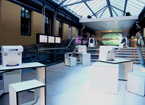
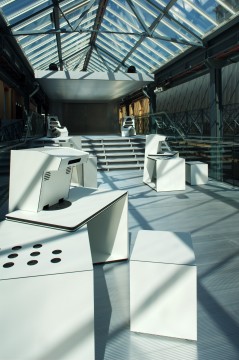
T he “Console”
was developed as a prototype installation to impart complex content in the
Ars Electronica Center, and has been in serial production and distribution
since 2007 thanks to a joint venture with Kraftwerk.
The interaction design is a spin-off of the classic principle of collector’s cards and allows for
a very flexible way of dealing with topics since users simply arrange and
rotate the cards on a platform animated with content.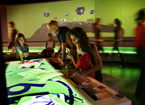
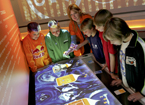
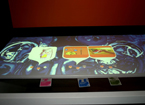 EventsT he atelier-lab’s approaches to the staging of events
range from purely artistic concepts to structuring themes and discourses and
preparing the content that they deal with. Various different modes of
depiction and interpretation of, for example, visual information or language
make it possible to influence the movements and activities of participants,
and to enable them to see complex or spontaneous events from perspectives
that would otherwise be impossible, or to intensify their effects.F ollowing this approach, there are two types of
multimedial features installed at the EU’s "The Sound of Europe"
conference: First of all, there’s the custom-designed, nine-screen media
display with a total projection area of about 160 m² in the Europasaal, the
main hall of Salzburg’s Congress Center; secondly, there are interactive media
installations in front of and inside the conference venue, as well as several
media art interventions that are an integral part of the conference’s
scheduled program and directly relate to the issues on which the proceedings
will focus. The media installations and infrastructure designed by the Ars
Electronica Futurelab react to the program of events being held at the
conference but do not intervene in or comment upon them; rather, these features
support the discussions by providing recapitulations and analytical visualizations.
The entire conference is endowed with a visual as well as a musical identity
that is derived directly from the panels’ topics and content rather than
merely providing a decorative embellishment of them.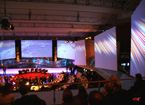
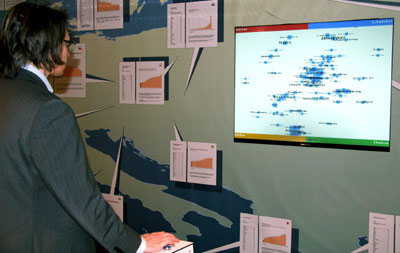
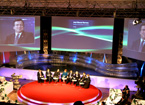 |
| © Ars Electronica Linz GmbH, info@aec.at | ||||||||||